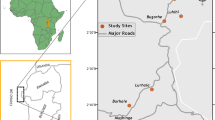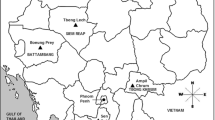Abstract
Livestock agrodiversity of Mazahua smallholder ‘campesino’ systems in the highlands of Central Mexico was investigated in the villages of San PabloTlalchichilpa (SPT) and La Concepción Mayorazgo (LCM). An animal inventory of 142 households in the two villages was made, followed by the monthly monitoring of 25 households through interviews and participant observation. Thirteen species of domestic animals were found, with a median of three species per farm. The main species werechickens, donkeys, sheep, cattle, mules, and horses, with some also keeping rabbits, ducks, and pigeons. Draught animals are fundamental. Poultry represents a dynamic asset that provides food, income, and short-term savings. Sheep are medium-term savings, and providestability. Livestock are managed in interaction with crops, providing draught force, manure, and cash, and receiving feed. Livestock are fed weeds of the maize crop and stover dring the dry season. Donkeys and sheep are also grazed on common land and in the fields after harvest. High prices for sheep have meant more flocks with possible detrimental environmental effects. Men usually own the draught animals, although anyone may own animals. Women are commonly owners of small stock and receive animals as wedding presents or inheritance. Other arrangements include shared ownership and borrowing. Livestock and produce may be traded in regional markets but are generally sold locally.,Campesinos are aware of unfavorable local terms, but reckon possible benefits do not warrant increased transportation costs and time. The villagers say their animals allow them to meet their needs and remain in their villages while improving their livelihoods.
Similar content being viewed by others
References
Arriaga-Jordán, C. M., González-Díaz, J. G., González-Esquivel, C. E., Nava-Bernal, E. G., and Velázquez-Beltrán, L. G. (1997). Caracterización de los Sistemas de Producción Campesinos en Dos Zonas del Municipio de San Felipe del Progreso, México: Estrategias Contrastantes. In Rivera Herrejón, G., Arellano Hernández, A., González-Díaz, L., and Arriaga-Jordán, C. (eds.), Investigación para el Desarrollo Rural: Diez Años de Experiencias del CICA, Universidad Autónoma del Estado de México, Toluca, México, pp. 171–197.
Arriaga-Jordán, C. M., and Pearson, R. A. (2004). The contribution of livestock to smallholder livelihoods: the situation in Mexico. In, Owen, E., Smith, T., Steele, M. A., Anderson, S., Duncan, A. J., Herrero, M., Leaver, J. D., Reynolds, C. K., Richards J. I., and Vera, J. K. (eds.), Responding to the Livestock Revolution—the role of globalisation and implications for poverty alleviation, Nottingham University Press, Nottingham, UK, pp. 99–115.
Brookfield, H., Stocking, M., and Brookfield, M. (1999). Guidelines on agrodiversity in demonstration site areas. PLEC News and Views (Special Issue on Methodology) 13: 17–31.
Castelán-Ortega, O., González-Esquivel, C., Arriaga-Jordán, C., and Chávez-Mejía, C. (2003). Mexico. In Brookfield, H., Parsons, H., and Brookfield, M. (eds.), Agrodiversity: Learning from Farmers Across the World, The United Nations University, Tokyo, Japan, pp. 249–269.
Chávez-Mejía, C., Nava-Bernal, G., and Arriaga-Jordán, C. (1998). Elements of biodiversity in homegardens in the highlands of Central Mexico. PLEC News and Views 11: 18–19.
Chávez-Mejía, M. C., Nava-Bernal, G., Velázquez-Beltrán, L., Nava-Bernal, Y., Mondragón-Pichardo, J., Carbajal-Esquivel, H., Pedraza-Fuentes, A. M., Reyes-Reyes, B. G., and Arriaga-Jordán C. (2001). A Research Approach for Rural Development in the Mountains of Central México. Mountain Research and Development 21: 113–117.
Devendra, C. (1993). Sustainable animal production from small farm systems in South-East Asia. FAO Animal Production and Health Paper 106, Food and Agriculture Organization of the United Nations, Rome.
Dolberg, F. (2001). A livestock development approach that contributes to poverty alleviation and widespread improvement of nutrition among the poor. Livestock Research for Rural Development, 13 (5): http://www.cipav.org.co/lrrd/lrrd13/5/dolb135.htm
González-Díaz, J., Velázquez-Beltrán, L., Espinoza Ortega, A., and Arriaga-Jordán, C. (1994). Draught animals in smallholder (campesino) farming systems in the Highlands of Central México. Draught Animal News 21: 7–10.
González D. J. G., Arriaga-Jordán, C. M., and Sánchez, V. E. (1996). The role of cattle and sheep in campesino (peasant) production systems in the highlands of central Mexico. In Dent, J. B., McGregor, M. J., and Sibbald, A. R. (eds.), Livestock farming systems: research, development socioeconomics and the land manager, Proceedings of the third international symposium on livestock farming systems, EAAP Publication No. 79, Wageningen Pers, Wageningen, The Netherlands, pp. 103–108.
González-Esquivel, C. E., Velázquez-Beltrán, L. G., Arriaga-Jordán, C. M., and Sánchez-Vera, E. (1995). Comparación de aves (Gallus gallus) tipo criollo con aves de líneas comerciales bajo condiciones de traspatio en sistemas de producción campesinos del Altiplano Mexicano. Ciencia Ergo Sum 2: 239–246.
Instituto Nacional de Estadística, Geografía e Informática. (1996). XI Conteo de Población y Vivienda 1995. Estado de México. INEGI. Aguascalientes, México.
Kang'ara, J. N., Ngoroi, J. M., Muturi, J. M., Amboga, S. A., Ngugi, F. K., and Moooangi, I.(2002). The role of livestock in soil no fertility, biodiversity, land use, culture and welfare change in Nduuri Embu, Kenya: http://www.unu.edu/env/plec/clusters/Eastafricanov2001/Kang'ara.pdf
Lawrence, P. R. and Pearson, R. A. (2002). Use of draught animal power on small-scale mixed farms in Asia. Agricultural Systems 71: 99–110.
Mohamed Saleem, M. A. (2001). Experience gained in the research-to-development continuum: Livestock research for sustainable livelihoods in the East African mountains. Mountain Research and Development 21: 118–122.
Reyes–Reyes, B. G. (1997). Los suelos del municipio de San Felipe del Progreso, Estado de México. In Rivera, H. G., Arellano, H. A., Gonzalez D. L., and Arriaga, J. C. (eds.), Investigación para el desarrollo rural: Diez años de experiencias del CICA, Universidad Autónoma del Estado de México, Toluca, México, pp. 259–269.
Sumberg, J. (2002). Livestock nutrition and foodstuff research in Africa: when is a nutritional constraint not a priority research problem? Animal Science 75: 332–338.
von Keyserlingk, A. (1999). The use of donkeys in the Mexican Central Highlands, A Gender Perspective. Development in Practice 9: 437–448.
Woodgate, G. R. (1994). Local Environmental Knowledge, Agricultural Development and Livelihood Sustainability in Mexico. Ines Redclift, M. and Sage, C. (eds.), Strategies for Sustainable Development, John Wiley and Sons, Chichester, UK, pp. 133–170.
Author information
Authors and Affiliations
Rights and permissions
About this article
Cite this article
Arriaga-Jordán, C.M., Pedraza-Fuentes, A.M., Nava-Bernal, E.G. et al. Livestock Agrodiversity of Mazahua Smallholder CampesinoSystems in the Highlands of Central Mexico. Hum Ecol 33, 821–845 (2005). https://doi.org/10.1007/s10745-005-8212-9
Issue Date:
DOI: https://doi.org/10.1007/s10745-005-8212-9




